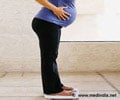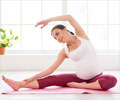- What Is fertility? - (https://americanpregnancy.org/getting-pregnant/what-is-fertility/)
- Fertility explained - (https://www.varta.org.au/understanding-fertility/fertility-explained)
- Infertility - (https://www.who.int/news-room/fact-sheets/detail/infertility)
- Fertility and Reproductive Health - (https://www.hopkinsmedicine.org/health/conditions-and-diseases/fertility-and-reproductive-health)
- Infertility FAQs - (https://www.cdc.gov/reproductivehealth/infertility/index.htm)
- The Effect of Moderate Intensity Aerobic Exercise on Affect and Exercise Intention in Active and Inactive College Students - (https://www.ncbi.nlm.nih.gov/pmc/articles/PMC6719814/)
- The role of exercise in improving fertility, quality of life and emotional wellbeing - (https://www.yourfertility.org.au/sites/default/files/2018- 08/The_role_of_exercise_in_improving_fertility.pdf)
- Maternal physical and sedentary activities in relation to reproductive outcomes following IVF - (https://www.rbmojournal.com/article/S1472-6483(16)30406-0/fulltext)
- Body mass index, physical activity and fecundability in a North American preconception cohort study - (https://www.fertstert.org/article/S0015-0282(16)61103-2/fulltext)
- Serum leptin levels and reproductive function during the menstrual cycle - (https://www.ncbi.nlm.nih.gov/pmc/articles/PMC3943486/)
- Adipose Tissue as an Endocrine Organ - (https://www.sciencedirect.com/science/article/abs/pii/S1043276000003015)
- The expression of leptin and its receptor during different physiological stages in the bovine ovary - (https://pubmed.ncbi.nlm.nih.gov/19908249/)
- Leptin levels and luteinizing hormone pulsatility in normal cycling women and their relationship to daily changes in metabolic rate - (https://pubmed.ncbi.nlm.nih.gov/18304548/)
- ACSM's Guidelines for Exercise Testing and Prescription 9th Ed. 2014 - (https://www.ncbi.nlm.nih.gov/pmc/articles/PMC4139760/)
- Guide to Physical Activity - (https://www.nhlbi.nih.gov/health/educational/lose_wt/phy_act.htm)
- The benefits of exercising/being active when trying to conceive - (https://www.tommys.org/pregnancy-information/planning-a-pregnancy/are-you-ready-to-conceive/being- active-when-trying-conceive)
What is Fertility?
Fertility is one’s natural ability to conceive or induce conception (fusion of egg and sperm to form embryo)(1✔ ✔Trusted Source
What Is fertility?
Go to source).
The process of embryogenesis (development and formation of an embryo) is then maintained by the production of progesterone (female reproductive hormone) by ovaries (female reproductive organ) and human chorionic gonadotropins (HCG- pregnancy hormone produced by growing embryo)(2✔ ✔Trusted Source
Fertility explained
Go to source).
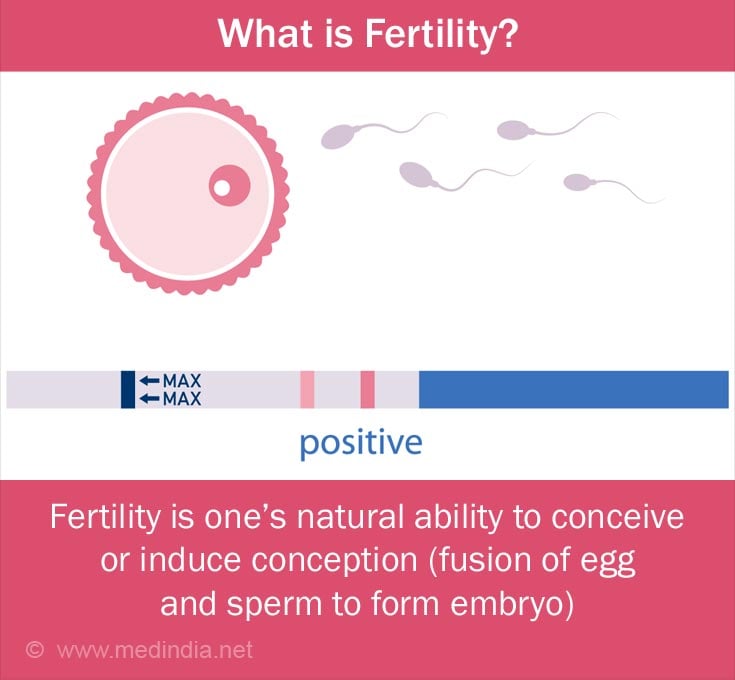
Infertility: An Issue to Address
Many take fertility for granted. However, it is a complex process with several factors that may affect it and result in infertility(2✔ ✔Trusted Source
Fertility explained
Go to source).
Infertility is a condition in which there is a failure to conceive. It is the inability to achieve pregnancy after 12 months or more of regular unprotected sexual intercourse, according to the World Health Organization (WHO)(3✔ ✔Trusted Source
Infertility
Go to source).
In the US, infertility affects 10-15% of couples. Globally, there are estimated to be 48 million couples and 186 million individuals affected by infertility(3✔ ✔Trusted Source
Infertility
Go to source).
Although there is a common assumption that infertility is related to women alone, they represent only one-third of infertility cases, one-third being represented by men and the remaining one-third includes unidentified causes(3✔ ✔Trusted Source
Infertility
Go to source).
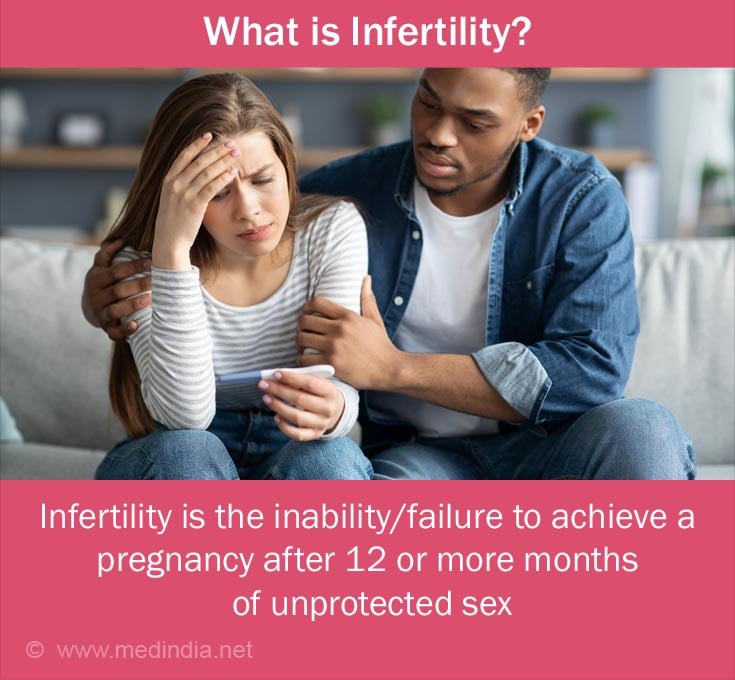
Infertility in males may result from hormonal imbalance, impaired functioning of testicles, or via genetic insults. These can be confirmed through semen analysis by evaluating the sperm concentration, motility, and shape (morphology)(4✔ ✔Trusted Source
Fertility and Reproductive Health
Go to source).
Likewise, in females, impairment in their reproductive organs (ovaries, fallopian tubes, and uterus) may lead to infertility(5✔ ✔Trusted Source
Infertility FAQs
Go to source). As the development of a healthy embryo mandates the proper functioning of hormones in women, hormonal dysregulation may contribute to infertility(2✔ ✔Trusted Source
Fertility explained
Go to source).
It is thereby imperative to evaluate environmental and lifestyle factors that may also interfere with the fertility of an individual(4✔ ✔Trusted Source
Fertility and Reproductive Health
Go to source).
How Does Exercise Affect Fertility?
Lifestyle factors like physical activities play a vital role in overall physiological and psychosocial health(6✔ ✔Trusted Source
The Effect of Moderate Intensity Aerobic Exercise on Affect and Exercise Intention in Active and Inactive College Students
Go to source). Exercise is beneficial for fertility and thereby managing weight is one of the keys to a healthy pregnancy(7✔ ✔Trusted Source
The role of exercise in improving fertility, quality of life and emotional wellbeing
Go to source).
Although several studies support the beneficial effects of exercise (both intense and moderate) on ovulation, pregnancy, and overall fertility, recent reports suggest that very high-intensity exercise imposes deleterious effects on pregnancy. Moreover, the hazardous effects of high-intensity exercise are also evident among men as it impairs sperm quality(7✔ ✔Trusted Source
The role of exercise in improving fertility, quality of life and emotional wellbeing
Go to source).
It reinforces that the link between physical activity and pregnancy is complex and multifactorial, thereby requiring authorized guidelines on exercise regimes during pregnancy(8✔ ✔Trusted Source
Maternal physical and sedentary activities in relation to reproductive outcomes following IVF
Go to source).
What Exercises to Avoid When Trying to Conceive?
Generally, for a healthy individual, a minimum of 30 minutes of moderate-intensity physical activity per week is recommended as per international guidelines(7✔ ✔Trusted Source
The role of exercise in improving fertility, quality of life and emotional wellbeing
Go to source). Hence, classifying the types of physical activities that might be strenuous or vigorous depends upon one’s intensity of exercise(8✔ ✔Trusted Source
Maternal physical and sedentary activities in relation to reproductive outcomes following IVF
Go to source).
Moderate exercise of fewer than five hours per week, and more than one hour, improves fertility among women(8✔ ✔Trusted Source
Maternal physical and sedentary activities in relation to reproductive outcomes following IVF
Go to source). However, on the contrary, high-intensity exercise (aerobic exercises of more than seven hours per week) is found to impair fertility(9✔ ✔Trusted Source
Body mass index, physical activity and fecundability in a North American preconception cohort study
Go to source).
Intense exercises that may interfere with pregnancy. Therefore, when trying to conceive, it is best to avoid the following exercises(9✔ ✔Trusted Source
Body mass index, physical activity and fecundability in a North American preconception cohort study
Go to source):
- High-intensity interval training
- Aerobic exercise
- Weight training (powerlifting)
- CrossFit
- Running
Relationship Between Intense Exercise and Infertility
Intense exercise (70% to 85% of your maximum heart rate) impairs ovulation in women. It may be due to luteal phase defect — lower levels of progesterone that may inhibit the implantation of the fertilized egg and lead to infertility or exercise-induced dysregulation of reproductive hormones (GnRH, LH, FSH, and estradiol)(9✔ ✔Trusted Source
Body mass index, physical activity and fecundability in a North American preconception cohort study
Go to source).
Intense exercise interferes with other physiological processes like appetite and metabolism via changes in leptin levels (a hormone that regulates appetite)(10✔ ✔Trusted Source
Serum leptin levels and reproductive function during the menstrual cycle
Go to source).
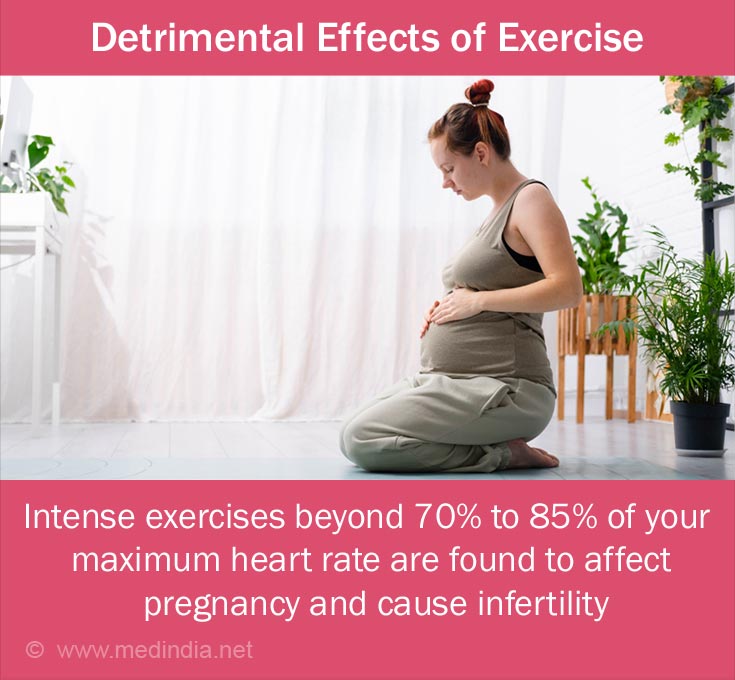
Changes in leptin may lead to lower food consumption and exert an effect on reproductive hormones (like estradiol production), thereby affecting ovulation and causing infertility(11✔ ✔Trusted Source
Adipose Tissue as an Endocrine Organ
Go to source).
The Corpus luteum (a healthy mass of cells that forms in an ovary and regulates ovulation) is also known to produce leptin(12✔ ✔Trusted Source
The expression of leptin and its receptor during different physiological stages in the bovine ovary
Go to source). Hence, changes in leptin levels may exert an effect on ovulation via gonadotropin-releasing hormones(13✔ ✔Trusted Source
Leptin levels and luteinizing hormone pulsatility in normal cycling women and their relationship to daily changes in metabolic rate
Go to source).
What Exercise Should You Do When Trying to Conceive?
Modification in one’s lifestyle influences pregnancy. Therefore, it is imperative to choose the type and duration of exercise carefully to maintain good preconception health(2✔ ✔Trusted Source
Fertility explained
Go to source).
As intense exercise has ill effects on pregnancy, it is advisable to reduce vigorous exercises to less than four hours per week. One may consider replacing intense exercises with moderate-intensity exercises or other workouts like walking or yoga (the idea is not to overstrain one’s system)(9✔ ✔Trusted Source
Body mass index, physical activity and fecundability in a North American preconception cohort study
Go to source).
On the contrary, moderate exercises (sustainable exercise, where one has to breathe deeply and not breathlessness) improve fertility among all women(9✔ ✔Trusted Source
Body mass index, physical activity and fecundability in a North American preconception cohort study
Go to source). When an individual reaches 64% to 76% of the age-predicted maximal heart rate (220 minus one’s age), the type of aerobic exercise is defined to be of moderate intensity as per the American College of Sports Medicine (ACSM)(14✔ ✔Trusted Source
ACSM's Guidelines for Exercise Testing and Prescription 9th Ed. 2014
Go to source).
This physiological change can be monitored by wearing a fitness tracker or a heart rate monitor. Hence, moderate exercises are within an individual’s exercise capability — done intermittently or all at one time(6✔ ✔Trusted Source
The Effect of Moderate Intensity Aerobic Exercise on Affect and Exercise Intention in Active and Inactive College Students
Go to source).
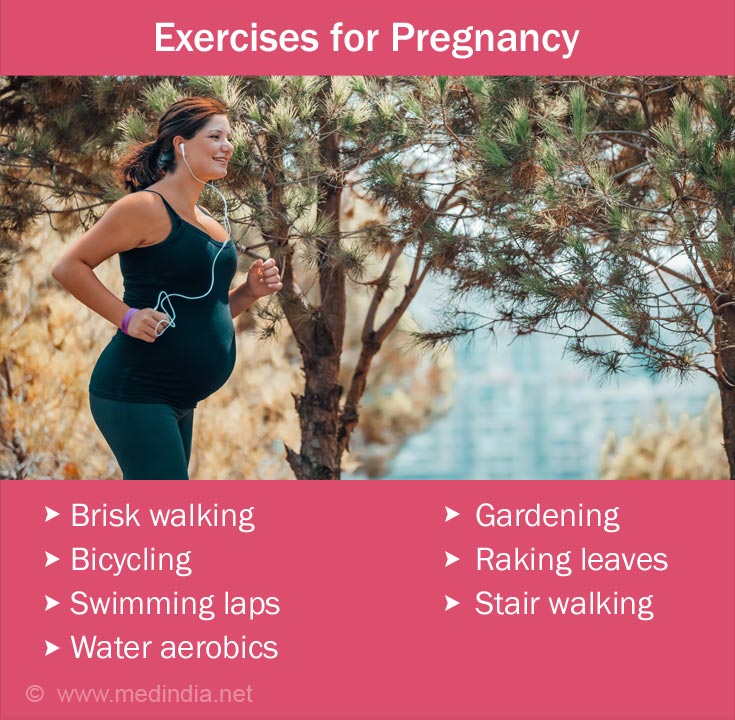
Some examples of moderate exercise include the following(15✔ ✔Trusted Source
Guide to Physical Activity
Go to source):
- Walking at least 35 minutes (20 min/mile)
- Bicycling (30 minutes)
- Swimming laps (20 minutes)
- Water aerobics (30 minutes)
- Fast dancing (30 minutes)
- Gardening
- Raking leaves
- Stair walking
As it is difficult to elucidate the varied causes of infertility, it is advised to ensure a moderate level of physical activity especially if one is planning to conceive or facing physical activity-related infertility issues(16✔ ✔Trusted Source
The benefits of exercising/being active when trying to conceive
Go to source).




